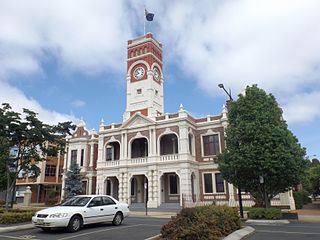
Toowoomba City Hall is a heritage-listed town hall at 541 Ruthven Street, Toowoomba, Toowoomba Region, Queensland, Australia. It was designed by Willoughby Powell and built in 1900 by Alexander Mayne. It is also known as Toowoomba Town Hall. It was added to the Queensland Heritage Register on 21 October 1992.

Breakfast Creek Hotel is a heritage-listed hotel at 2 Kingsford Smith Drive, Albion, City of Brisbane, Queensland, Australia. It was designed by Simkin & Ibler and built in 1889 to 1890 by Thomas Woollam & William Norman. It was added to the Queensland Heritage Register on 21 October 1992.

169 Mary Street is a heritage-listed warehouse at 169 Mary Street, Brisbane CBD, City of Brisbane, Queensland, Australia. It was designed by Richard Gailey and built from 1887 to 1888 by T Game. It is also known as Coal Board Building. It was added to the Queensland Heritage Register on 21 October 1992.

Toowoomba railway station is a heritage-listed railway station on the Western line at Russell Street, Toowoomba, Toowoomba Region, Queensland, Australia. It serves the city of Toowoomba, which is the junction for the Western, Main and Southern lines. The station has one platform with a passing loop, opening in 1867. It was designed by FDG Stanley and built in 1873 by R. Godsall. It was added to the Queensland Heritage Register on 21 October 1992.
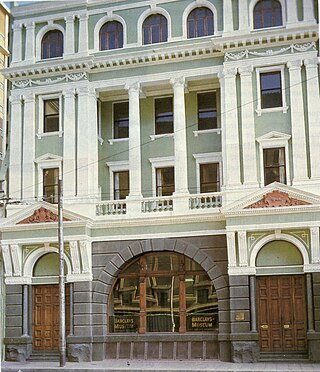
The Natal Bank Building is situated on Stand 194 at 90 Market Street in the city of Johannesburg. Natal Bank was the second bank to open a branch in the city after Standard Bank.

Corona Lodge was constructed as a Masonic Society Lodge in 1902. It is situated on stand 62 (1494) on O’Reilly Road in the Berea district of Johannesburg. Corona Lodge is one of the few remaining original buildings in this part of the city. The architect of the original building was J A Cope Christie.
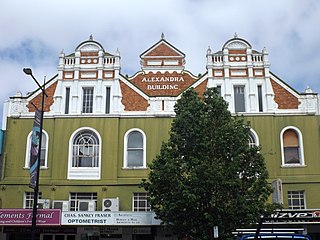
Alexandra Building is a heritage-listed commercial building at 451–455 Ruthven Street, Toowoomba, Queensland, Australia. It was designed by Toowoomba architect Henry James (Harry) Marks and built in 1902 by James Renwick. It was added to the Queensland Heritage Register on 16 October 2008.
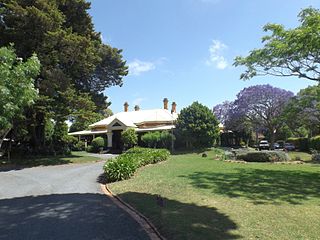
Vacy Hall is a heritage-listed villa at 135 Russell Street, Toowoomba, Toowoomba Region, Queensland, Australia. It was built c. 1899. It was added to the Queensland Heritage Register on 21 October 1992.

Beth-Eden is a heritage-listed villa at 85 Bank Road, Graceville, City of Brisbane, Queensland, Australia. It was designed by Richard Gailey and built from 1888 to 1910s. It is also known as Rakeevan and Verney. It was added to the Queensland Heritage Register on 21 October 1992.

Silverwells is a heritage-listed duplex at 261–267 Main Street, Kangaroo Point, Queensland, Australia. It was built from 1860s circa to 1860s circa. It is also known as Bishopcroft, Blairgowie, and Morningside. It was added to the Queensland Heritage Register on 21 October 1992.
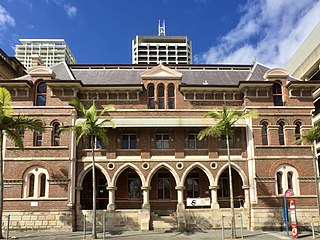
The Queensland Government Printing Office is a heritage-listed printing house at 110 George Street and 84 William Street, Brisbane City, Queensland, Australia. It was designed by John James Clark, Francis Drummond Greville Stanley, and Edwin Evan Smith and built from 1884 to 1887 by John Petrie and Thomas Hiron. It is also known as The Printing Building, Sciencentre, Public Services Club, and Registry of Births, Deaths & Marriages. It was added to the Queensland Heritage Register on 21 October 1992.
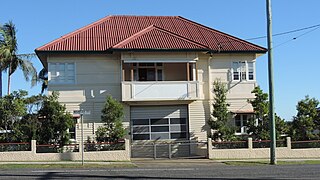
Wynnum Fire Station is a heritage-listed former fire station at 39 Mountjoy Terrace, Wynnum, City of Brisbane, Queensland, Australia. It was designed by Atkinson & Conrad and built from 1922 to 1938. It was added to the Queensland Heritage Register on 28 May 1999.

Empire Hotel is a heritage-listed hotel at 339 Brunswick Street, Fortitude Valley, City of Brisbane, Queensland, Australia. It was designed by Richard Gailey and built in 1888 by Smith and Ball. It was renovated in 1925 to a design by Richard Gailey, Junior. It was further renovated in 1937 to incorporate apartments designed by Hall and Phillips. It was added to the Queensland Heritage Register on 21 October 1992.

Rockhampton Post Office is a heritage-listed former post office at 80 East Street, Rockhampton, Rockhampton Region, Queensland, Australia. It was designed by George St Paul Connolly and built from 1892 to 1896 by Dennis Kelleher. It is also known as Rockhampton Post and Telegraph Offices. It was added to the Queensland Heritage Register on 24 January 2003.

William Mortimer (1841/42–1913) was an architect working in Lincoln from around 1858. He also played for the Lincolnshire County Cricket team.

The Port Pirie Post Office is a heritage-listed post office at 79-83 Ellen Street, Port Pirie, South Australia. It was designed by Edward Woods and built in 1880, with extensions designed by Charles Owen-Smyth built in 1905–1907. It was added to the South Australian Heritage Register on 12 October 1995 and added to the Commonwealth Heritage List on 8 November 2011.

Tumut Post Office is a heritage-listed post office at 82–84 Wynyard Street, Tumut, New South Wales, Australia. It was added to the Australian Commonwealth Heritage List on 22 August 2012.
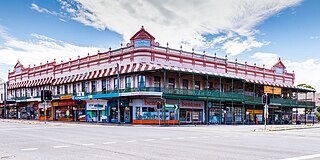
Goodman's Buildings is a heritage-listed retail building at 2-12 Johnston Street, Annandale, Inner West Council, Sydney, New South Wales, Australia. It was added to the New South Wales State Heritage Register on 2 April 1999.

Grahame's Corner is a heritage-listed commercial and office building located at 142-144 Pitt Street, in the Sydney central business district, in the City of Sydney local government area of New South Wales, Australia. It was designed by G. A. Morell and built from 1877 to 1882. It is also known as Grahams Corner and the AMFIS Building. The property was added to the New South Wales State Heritage Register on 2 April 1999.

Launceston Post Office is a heritage-listed post office at 68-72 Cameron Street, Launceston, Tasmania, Australia. It was designed by William Waters Eldridge, with alterations prior to opening designed by Corrie and North. It opened in 1891, while the clock tower was completed in 1903 and altered in 1910. It was added to the Australian Commonwealth Heritage List on 22 June 2004.






















